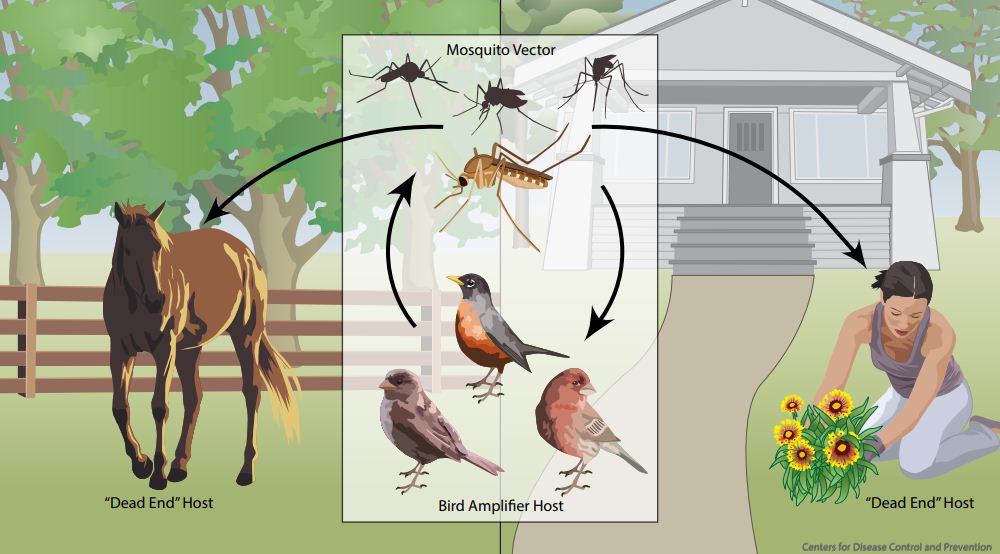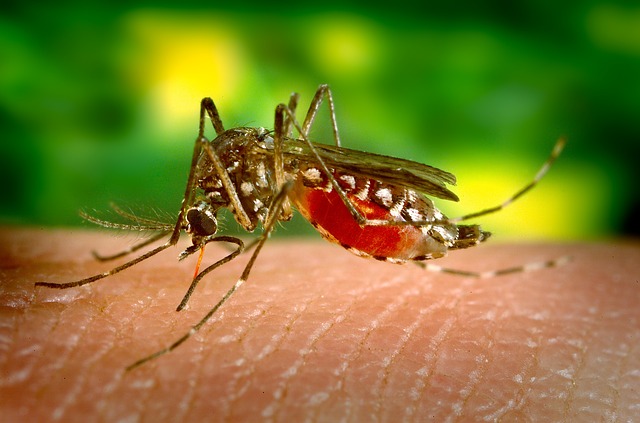Table of Contents
What is West Nile Virus?
West Nile Virus is a single-stranded RNA virus that causes West Nile fever. It was discovered in the West Nile district of Uganda in 1937 and was identified in birds (crows and columbiformes) in the Nile delta region in 1953. Before 1997 West Nile Virus was not considered pathogenic for birds. According to the World Health Organisation (WHO), West Nile Virus (WNV) is a member of the flavivirus genus and belongs to the Japanese encephalitis antigenic complex of the family Flaviviridae. WNV is a viral infection that is typically spread by mosquitoes and can cause fatal neurological disease as well as death in people. Cases of WNV are noticed during mosquito season, which starts in the summer and continues through fall. The largest outbreaks of WNV occurred in Greece, Israel, Romania, Russia, and the USA. Outbreak sites are on major birds migratory routes. WNV is sustained in nature in a cycle involving transmission between birds and mosquitoes. Humans, horses and other mammals can also be infected.
Symptoms of West Nile Virus
According to the WHO, about 80% of people who are infected fro WNV will not show any symptoms. Hence, in most cases, infection with WNV is asymptomatic (no symptoms). Approximately 20% of people who become infected with WNV will develop West Nile fever or severe West Nile disease.
- Symptoms include fever, headache, tiredness, and body aches, nausea, vomiting, occasionally with a skin rash and swollen lymph glands. Most people with this type of WNV disease recover completely, but fatigue and weakness can last for weeks or months.
- The symptoms of the severe disease such as West Nile encephalitis (inflammation of the brain) or West Nile meningitis (inflammation of the membranes that surround the brain and spinal cord) or West Nile polio include headache, high fever, neck stiffness, stupor(a state of near-unconsciousness or insensibility), disorientation, coma, tremors, convulsions, muscle weakness, and paralysis.
It is estimated that approximately 1 in 150 persons infected with the West Nile virus will develop a more severe form of the disease. Severe illness can occur in people of any age; however, people over 50-60 years of age are at greater risk. People with certain major medical conditions, such as cancer, diabetes, hypertension, kidney disease, and people who have received organ transplants, are also at greater risk.
Recovery from severe illness might take several weeks or months. Some effects on the central nervous system might be permanent. About 1 out of 10 people who develop severe illness affecting the central nervous system die.
Diagnosis of West Nile Virus
West Nile virus can be diagnosed by a number of different tests:
- IgG (Immunoglobulin G) antibody seroconversion (or a significant increase in antibody titers) in two serial specimens collected at a one-week interval by enzyme-linked immunosorbent assay (ELISA);
- IgM (Immunoglobulin M) antibody capture enzyme-linked immunosorbent assay (ELISA);
- neutralization assays;
- viral detection by reverse transcription polymerase chain reaction (RT-PCR) assay, and
- virus isolation by cell culture.
Treatment of West Nile Virus
- No vaccine or specific antiviral treatments for West Nile virus infection are available for humans.
- Use of pain relievers to reduce fever or to relieve some symptoms of the fever.
- In severe cases, patients often need to be hospitalized to receive supportive treatment, such as intravenous fluids, pain medication, and nursing care.
Transmission Cycle of West Nile Virus
WNV is maintained in nature in a mosquito-bird-mosquito transmission cycle. Mosquitoes of the genus Culex are generally considered the main vectors of WNV, in particular, Cx. Pipiens. WNV is maintained in mosquito populations through vertical transmission i.e., adults to eggs.
Birds are the reservoir hosts of WNV. In Europe, Africa, the Middle East, and Asia, mortality in birds, associated with WNV infection, is rare. In striking contrast, WNV is highly pathogenic for birds in the Americas. Members of the crow family (Corvidae) are particularly susceptible, but the virus has been detected in dead and dying birds of more than 250 species. Birds can be infected by a variety of routes other than mosquito bites, and different species may have different potential for maintaining the transmission cycle.

West Nile Virus Transmission Cycle
Image credit to “Centers for Disease Control and Prevention”
Horses, just like humans, are dead-end hosts, meaning that while they become infected, they do not spread the infection. Symptomatic infections in horses are also rare and generally mild but can cause neurologic disease, including fatal encephalomyelitis.
West Nile virus is not spread:
- Through coughing, sneezing, or touching
- By touching live animals
- From handling live or dead infected birds. Avoid bare-handed contact when handling any dead animal. If you are disposing of a dead bird, use gloves or protective covering like thick plastics to place the carcass in a garbage can.
- Through eating infected birds or animals. Always follow instructions for fully cooking meat from either birds or mammals.
Also Read: Atmospheric Waves Experiment || Bolo App by Google for kids in India
Prevention of West Nile Virus infection
As there is no human vaccine available for humans, the best and obvious method to reduce the risk of infections is by avoiding mosquito bites. This may be done by getting rid of standing pools of water, such as in old tires, buckets, gutters, and swimming pools. Mosquito repellent, window screens, mosquito nets, by wearing light-colored clothing (long-sleeved shirts and trousers) and by avoiding outdoor activity at peak biting times may also be useful.
Effective prevention of West Nile Virus infections (in humans) depends on the development of comprehensive, integrated mosquito surveillance and control programmes in areas where the virus occurs. Special importance should be to integrated control measures including source reduction (with community participation), water management, chemicals, and biological control methods.
Reducing the risk of animal-to-human transmission. protective covering such as gloves should be worn while handling sick animals or their tissues, and during slaughtering and culling procedures.
Reducing the risk of transmission through blood transfusion and organ transplants. Blood and organ donation restrictions and laboratory testing should be considered especially at the time of the outbreak in the affected areas after assessing the local/regional epidemiological situation.
Since WNV outbreaks in animals precede human cases, the establishment of an active animal health surveillance system to detect new cases in birds and horses is essential in providing early warning for veterinary and human public health authorities. In the Americas, it is important to help the community by reporting dead birds to local authorities.
Vaccines have been developed for horses. Treatment is supportive and consistent with standard veterinary practices for animals infected with a viral agent.
You may also like to read –
- The First Ever REAL Black Hole Image
- “Chain-melted state” – A new state of matter discovered
- First Ever REAL Black Hole Image
- Stephen Hawking’s theory of Dark Matter ruled out
- World’s first country to launch 5G mobile services




7 Comments
Darlene Lichtenfeld · March 27, 2019 at 6:19 am
Perfectly written written content , thanks for entropy.
Meera Bajaj · March 30, 2019 at 3:30 pm
Now I’ve a complete understanding of West Nile Virus. Thanks to studiouslyyours.com
have bookmarked for future.
Julieta Steelman · April 3, 2019 at 3:36 pm
tysm for this article, it is quite helpful to me! Much better written than anything else out there.
atul · April 3, 2019 at 5:18 pm
Thank you, Julieta! Stay tuned!
Andrew · April 5, 2019 at 11:16 pm
This is an informative piece of content. Keep writing.
Mission Shakti : anti-satellite missile - STUDIOUSLY YOURS · March 29, 2019 at 7:55 pm
[…] Check : West Nile Virus || Atmospheric Waves Experiment (AWE) || Bolo App by […]
PSLV-C45 mission (EMISAT satellite) - STUDIOUSLY YOURS · March 31, 2019 at 11:39 pm
[…] may also like to read: Mission Shakti || West Nile Virus || Bolo App || Atmospheric Waves […]